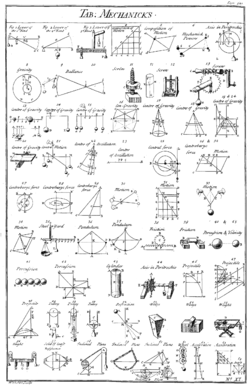A pulley is a wheel with a groove along its edge for holding a rope or cable. It is a simple machine that helps change the direction and point of application of a pulling force. Pulleys are usually used in sets designed to reduce the amount of force needed to lift a load. The magnitude of the force is reduced, but it must act through a longer distance. Consequently, the amount of work necessary for the load to reach a particular height is the same as the amount of work needed without the pulleys.
Pulleys can be found in many different applications around us. Not only are they used for the obvious lifting of objects, such as by cranes, but they are also used in modern automobiles and airplanes. Pulleys are also essential for most machines in some form or other.
As is the case with all the simple machines, the origin of the pulley is unknown. When early peoples lifted heavy objects by throwing vines or other crude ropes over tree limbs, they used the idea of a single fixed pulley to change the direction of a force. But since there was no wheel to turn, this use resulted in considerable
friction. It is believed that by 1500
B.C.E. people in Mesopotamia used rope pulleys for hoisting water.
[1]
It is not recorded when or by whom the pulley was first developed. It is believed however that
Archimedes developed the first documented block and tackle pulley system, as recorded by
Plutarch. Plutarch reported that Archimedes moved an entire warship, laden with men, using compound pulleys and his own strength.
TYPES OF PULLEY
- Fixed A fixed or class 1 pulley has a fixed axle. That is, the axle is "fixed" or anchored in place. A fixed pulley is used to redirect the force in a rope (called a belt when it goes in a full circle. A fixed pulley has a mechanical advantage of one.
- Movable A movable or class 2 pulley has a free axle. That is, the axle is "free" to move in space. A movable pulley is used to transform forces. A movable pulley has a mechanical advantage of two. That is, if one end of the rope is anchored, pulling on the other end of the rope will apply a doubled force to the object attached to the pulley.
- Compound A compound pulley is a combination fixed and movable pulley system.
- Block and tackle - A block and tackle is a compound pulley where several pulleys are mounted on each axle, further increasing the mechanical advantage.
Pulleys are able to change the direction of the force.
Uses of Pulleys
Pulleys have been used for lifting for thousands of years. The most prevelant and oldest example are their uses on ships and
boats. The block and tackle have been a key tool for raising sails and cargo. Another major use for pulleys is with
cranes.
Pulleys have been used also in modern times with various machines and systems. Even in the space age, pulleys have been an important aspect for the construction and operations of spacecraft and aircraft. It is with a pulley system that rudders for an aircraft are controlled.
Pulleys are used in everyday life, from vehicles to moving equipment such as crane
